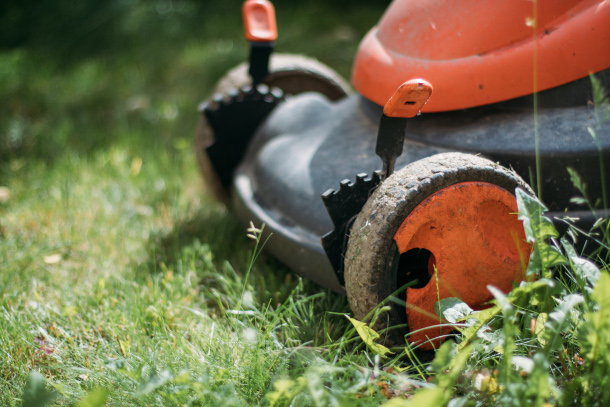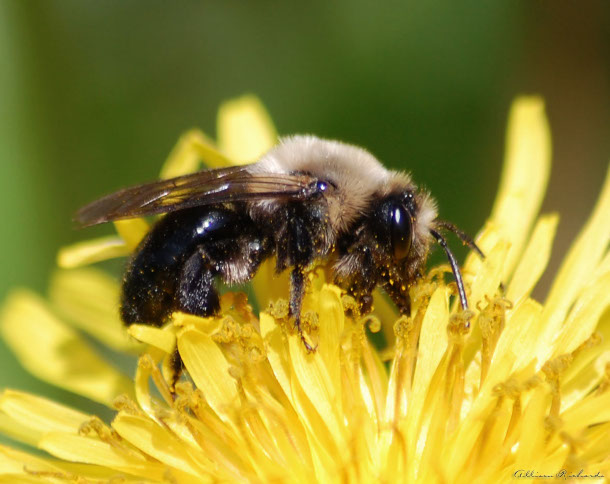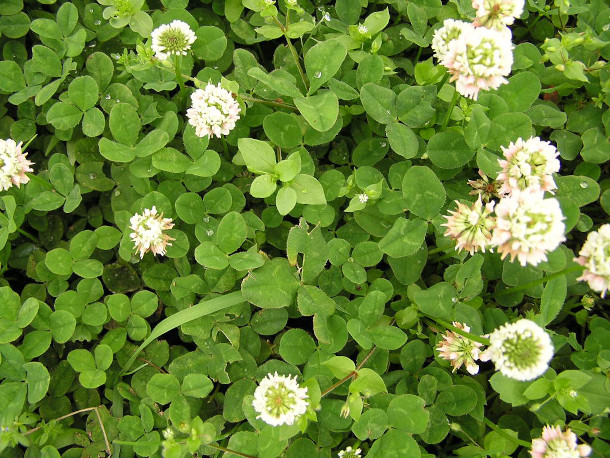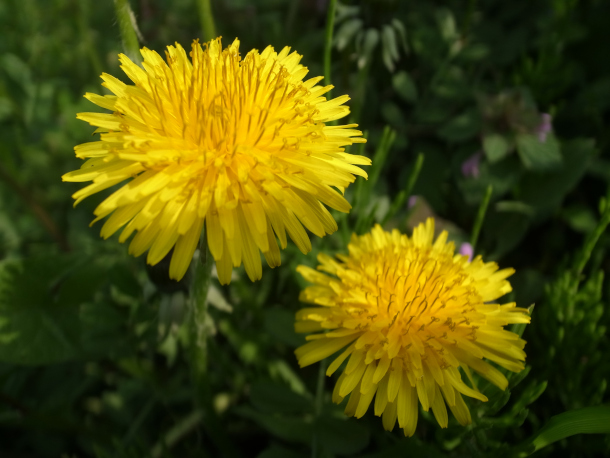No-Mow May
Air Date: Week of May 5, 2023

Leaders in the “No-Mow May” movement stress that there is a key window of time–anywhere from February to May depending on an area’s climate–when vital food sources for pollinators should be allowed to flourish. (Photo: Ivan Radic, Flickr, CC BY 2.0)
Biologists are encouraging homeowners to leave their lawnmower in the garage for a month this spring to create crucial habitat for pollinators. A proponent of the "No-Mow May" movement, Biology Professor Israel Del Toro from Lawrence University joins Host Bobby Bascomb to discuss why we should be rethinking our lawn care habits.
Transcript
BASCOMB: Spring is in full swing across the North and some may feel the urge to get out the lawn mower and tidy up but there is a growing push towards letting our lawns grow for the month of May. The No Mow May movement aims to give insects just emerging from hibernation access to critical sources of food like dandelions and violets before we mow them down with the grass. Insect populations, including many critical bee and other pollinator species, are in dramatic decline, threatening food webs in nature and food security for humans. But communities that let the grass grow this month have seen a tremendous increase in pollinators, a 5-fold increase in pollinator abundance and a threefold increase in the diversity of insects. Israel Del Toro is a biology professor at Lawrence University in Appleton, Wisconsin, one of the communities that has embraced No Mow May.
DEL TORO: The idea is pretty simple. May is actually a really important time for our pollinators that are just coming out of hibernation. So many of the species of bees that we have in the US are solitary bees that over-winter underground. And so the idea behind No-Mow May is to basically let our lawns grow out and provide some early season flowers for our pollinators that are coming out of hibernation to feed on.
BASCOMB: Well, this time of year in my own yard, I'm seeing dandelions and some violets coming out. But what kind of flowers are we talking about here? I'm sure of course, it's gonna to vary across the country, but generally, what are you seeing?
DEL TORO: Yeah, things that we would normally consider weedy species are actually really important food sources for our pollinators. So things like what you just mentioned: dandelions, clovers, violets, all of those are resources, whether native or not, that our native bees are actually depending on. Now, don't get me wrong, I'm all about removing invasives and reducing invasive species as well. But we also want to make sure that we strike a balance in working with the biodiversity in our backyards.
BASCOMB: Well, tell me more about the insects and pollinators specifically that we're talking about here.

There are about four to five thousand species of native bees in the United States alone, and many of them rely on naturally growing vegetation in urban spaces. (Photo: Allison Richards, Flickr, CC BY-NC-ND 2.0)
DEL TORO: Yep, so pollinator diversity is actually really huge. If we look at the entire US as a whole, we're looking at about four to five thousand different species of native bees. Most of them are solitary bees, and actually very few are colonial like honey bees, or semi-colonial like bumblebees. The rest of them tend to be solitary. They nest underground, they nest in decaying wood. Some of them lie in their burrows with leaves, those are your leaf cutter bees, or others will dig out little burrows inside of walls. And those might be your mason bees. And so we have quite a big diversity of bees. Here in Wisconsin, we have about 500 different species of bees that are native to Wisconsin. And amongst that biodiversity, we also have rare and endangered species. So a good example of that is the rusty patched bumblebee. The rusty patched bumblebee is federally listed as it's a critically endangered species due primarily to habitat loss. But one of the cool things that we're seeing is that these urban habitats that we're generating as a result of No-Mow May, can actually result in bringing back some of those populations into urban spaces.
BASCOMB: So even somebody that maybe doesn't care so much about bees or insects, but might like to hang that bird feeder outside their window and see birds, maybe they should think about taking up this No-Mow May. I mean, insects are so foundational to many species that we care about.
DEL TORO: Absolutely. So with insects being at the base of many of these food webs, birds and other small mammals rely on them as a part of their diet. So by increasing the abundance of insects in general, we can really start to help the broader ecosystem as well. One of the other cool things that we see as part of No-Mow May, so let's say animals and insects and birds aren't your thing, but maybe plants are your thing. No-Mow May also gives an opportunity for rare and endangered species of plants to pop up, things that might not normally show up.
BASCOMB: Wow, that's really interesting. So it sounds like May specifically is a really critical window for a lot of things.
DEL TORO: Yep, May is when nature is waking up from winter, right? Now depending on where you are in the US, No-Mow May may might not be the right time for you to not mow your lawn. It might be No-Mow April if you're further south, or No-Mow March, just depending on where you are, and wherever the seasonality is appropriate.

Bees are not the only species that can benefit from No-Mow May. A variety of rarer plants and insects are also free to thrive when our lawns are not as manicured. (Photo: Yamanaka Tamaki, Flickr, CC BY-NC-ND 2.0)
BASCOMB: Well, how big is the potential impact of yards, for pollinators and for wildlife in general? I mean, we grow a lot of grass in this country.
DEL TORO: That's right. So grass is probably our predominantly most homogeneous crop that we grow as a country and we manage it so heavily, right, we put all of these chemicals, fertilizers, herbicides, pesticides, and to have that greenest lawn. And maybe this is an opportunity for us to rethink some of those habits and educate ourselves on what the best practices are, and maybe reducing our fertilizer use or reducing harmful chemicals that are known carcinogens. For example, glyphosate and neonicotinoids are really bad for our pollinator populations. But they're also really bad for us humans. The European Union, for example, has declared glyphosates as known carcinogens, and we still keep putting them on our lawns, and often overusing these chemicals. So this is an opportunity for us to think about what's good for the environment, but also what's good for our own health and our practices on how we manage our little bits of plots of land.
BASCOMB: So we've been talking about holding back on mowing our lawns. What about cleaning up, you know, last year's leaves or pulling out those dead flower stalks? I understand a lot of insects make their winter homes in places like that.
DEL TORO: Absolutely. So No-Mow May isn't just an opportunity to be lazy. In fact, I encourage you to do the opposite. I encourage you to spend that time that you would normally spend mowing, educating yourself about other things that you can be doing for our pollinators throughout the summer and into the fall. And as you mentioned, going into the fall is a really important time where we can help create habitat, nesting habitat for these solitary bees. We like the idea of "leaving the leaves." The other great thing about leaving the leaves is that it becomes great compost for your yard and for your lawn in the next year. So not only are you protecting your pollinators, but you're fertilizing your landscape as well along the way
BASCOMB: Well, Israel, I have to tell you that this has become a bit of an issue in my own house here. My husband mows the lawn. And he's already talking about how long the grass is getting, I kind of think he's worried that the neighbors are gonna judge us for not keeping our yard neat enough. How do you respond to someone with those kinds of concerns?

While many may view plants like dandelions as a nuisance, they are actually important to a wide variety of pollinators. (Photo: Yoshiyuki IMAI, Flickr, CC BY-SA 2.0)
DEL TORO: Yeah, so the big thing is open communication and talking to your neighbors about what you're doing and why you're doing it. So if you decide to grow out your lawn for the month of May, the first thing we ask you to do is check with your local municipality to make sure that you're not violating some city ordinance. However, if your town is participating, or you are within your city ordinances, then you know, by all means, just talk to your neighbors. Let them know that yeah, my lawn’s gonna be a little shaggy this month. But that's okay. This is why I'm doing it. And I promise, come June, I'm gonna mow that thing. And we're all gonna be looking top shape. And you know, one of the things that we do is we provide signage for our communities to let people know that our wild looking lawns actually is a sense of organized chaos, that there is method to our madness, right, that we're not just being lazy gardeners, we're actually thinking about providing homes for our pollinators.
BASCOMB: So No-Mow May isn't a slippery slope to bedlam, then. It’s gonna be okay.
DEL TORO: No, I think No-Mow May is more of a slippery slope into learning about your biodiversity and educating yourself and your family, about the little things that crawl outside our house that are really important for our ecosystem.
BASCOMB: Israel Del Toro is a biology professor at Lawrence University in Appleton, Wisconsin.
Links
Living on Earth wants to hear from you!
Living on Earth
62 Calef Highway, Suite 212
Lee, NH 03861
Telephone: 617-287-4121
E-mail: comments@loe.org
Newsletter [Click here]
Donate to Living on Earth!
Living on Earth is an independent media program and relies entirely on contributions from listeners and institutions supporting public service. Please donate now to preserve an independent environmental voice.
NewsletterLiving on Earth offers a weekly delivery of the show's rundown to your mailbox. Sign up for our newsletter today!
 Sailors For The Sea: Be the change you want to sea.
Sailors For The Sea: Be the change you want to sea.
 The Grantham Foundation for the Protection of the Environment: Committed to protecting and improving the health of the global environment.
The Grantham Foundation for the Protection of the Environment: Committed to protecting and improving the health of the global environment.
 Contribute to Living on Earth and receive, as our gift to you, an archival print of one of Mark Seth Lender's extraordinary wildlife photographs. Follow the link to see Mark's current collection of photographs.
Contribute to Living on Earth and receive, as our gift to you, an archival print of one of Mark Seth Lender's extraordinary wildlife photographs. Follow the link to see Mark's current collection of photographs.
 Buy a signed copy of Mark Seth Lender's book Smeagull the Seagull & support Living on Earth
Buy a signed copy of Mark Seth Lender's book Smeagull the Seagull & support Living on Earth

